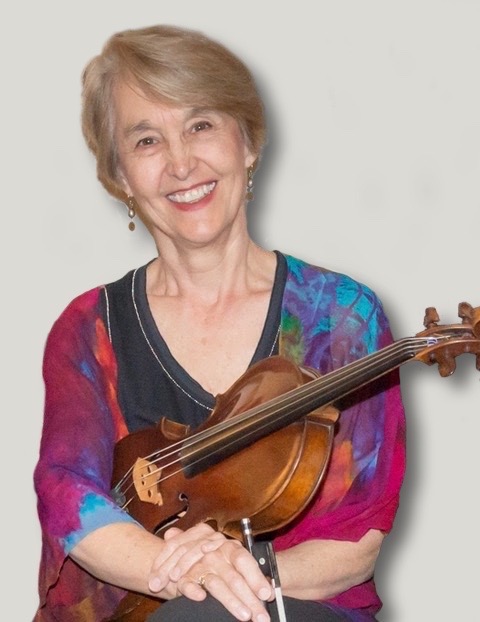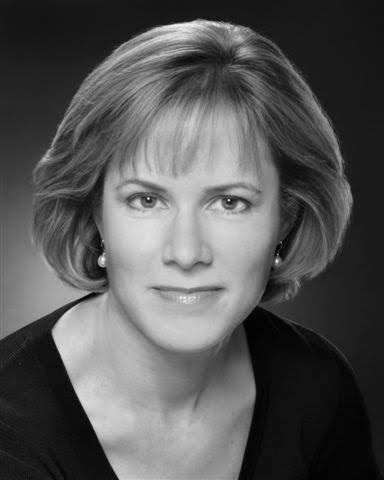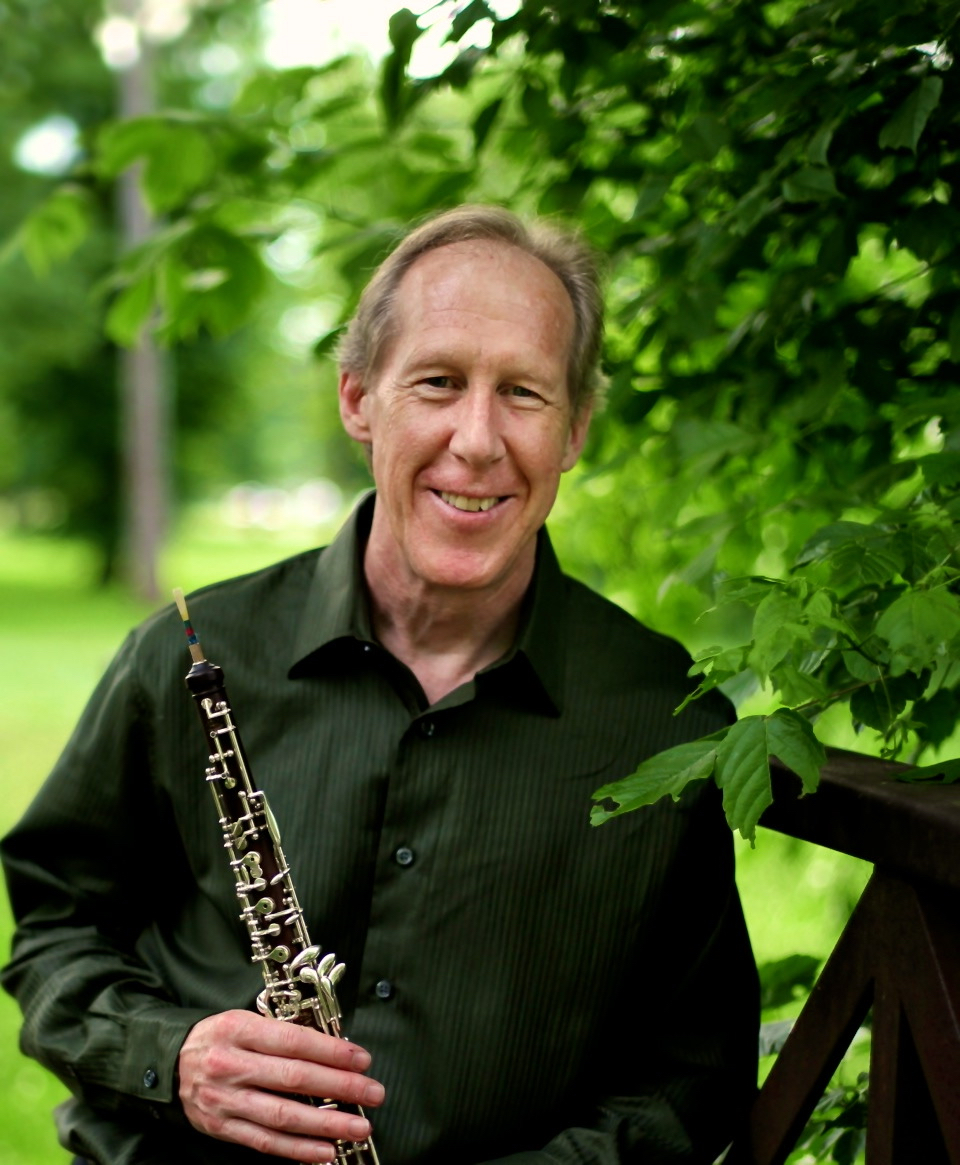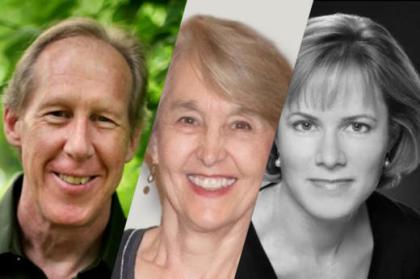Ballade in F minor for Viola and Piano (1927)
Minna Keal (1909–1999)
From the Apricot Tree for oboe and viola (2016)
Alexandra Bryant (b. 1985)
Written for Mark Hill and Katherine Murdock
INTERMISSION
Mook Nyum “Moment of Silence” for solo viola (2001)
Ann Park-Rose (b. 1979)
Sonata for Viola and Piano (1937)
Elizabeth Maconchy (1907–1994)
-
Allegro
-
Lento moderato
-
Presto
Ballade in F minor for Viola and Piano
MINNA KEAL (1909–1999)
Minna Keal was born Minnie Nerenstein on March 22, 1909 in the back room of her parents' Hebrew publishing business in the East End of London; a "true Cockney," as she liked to say. She was the eldest daughter of Yiddish-speaking Fanny and Jacob Nerenstein, who were Russian-Jewish immigrants. Though her parents had no musical training, Minna had an Uncle Leibel who played the violin very well; she remembered experiencing a lot of music in the household, particularly her mother's singing of Hebrew folk songs. She had always enjoyed playing the piano and in her early years Beethoven was her idol. She began composing tunes at the age of twelve, which she later described as "English with a Jewish overlay." Her father died in 1926 while Minna was still a teenager, and instead of going to university to study modern languages as planned, she attended the Royal Academy of Music, where she studied from 1928 to 1929. Minna remembered her composition teacher William Alwyn as a very good teacher and a fine composer who emphasized a good balance between strength and lyricism; he provided encouragement and support at the time of her first serious compositions.
Sadly, her promising career as a composer came to an abrupt halt: at the age of 20, she was forced to give up her musical studies to help her mother in the family business. She left the Royal Academy in 1929 and stopped composition for 46 years. However, she continued to play the piano and music continued to play an important part in her life.
Minna eventually retired from a series of uninspiring office jobs. She taught the occasional piano student, and at one point serendipitously met a piano teacher who learned of her early compositions; he was impressed enough to convince her to return to her studies and once again take up composition. Although in her mid-70’s, she realized that she wanted to speak in a more contemporary language in order to address a modern-day audience and began a vigorous study of contemporary music. Her new idols became Bartók, Shostakovich and Schoenberg. Once she became more comfortable composing in a modern style she felt a renewed enthusiasm, saying her life had become "rich and wonderful." She eventually wrote a major Symphony in 1987, which was given its world premiere with the BBC Symphony at the Proms two years later under the baton of Oliver Knussen, who had become her composition teacher.
In the words of Len Mullenger:
“There were no extra-musical programmes to her compositions, as she preferred to let her music speak for itself - she was an intuitive composer, not an analytical one. She wanted, above all, to express the turmoil of living in the twentieth century: the joy, sadness, chaos and frustration which had been packed into her crowded and rich life. She was always concerned about humanity as a whole rather than just herself and threw herself totally into the fray, sparing herself nothing. Music, she felt, should lift listeners out of themselves onto a higher plane of existence.”
The Ballade in F minor for Viola and Piano was among her compositions performed while studying at the Royal Academy of Music. It was much admired by the British master of the viola Lionel Tertis, and it won her a composition prize in 1929. It was first performed by Philip Burton in 1929 at the Royal Academy of Music, but has languished unjustly in manuscript until this first edition was published in 1993. It is a warm and passionate work which displays several elements of the composer's Jewish cultural heritage.
— Program Note drawn from Len Mullenger: Minna Keal
From the Apricot Tree
ALEXANDRA BRYANT (b. 1985)
Composer Alexandra Bryant has received commissions from the Kronos Quartet, the Cleveland Orchestra Youth Orchestra, William Preucil (former concertmaster of the Cleveland Orchestra), the Aeolus Quartet in collaboration with the Friends of Chamber Music of Reading and through a grant from the National Endowment of the Arts, Carmen Balthrop, Duo Scordatura and Scordatura Music Society, the Cleveland Museum of Natural History, the Santa Fe Youth Symphony Orchestra Association, the Tacoma Youth Symphony Association, The Greater Twin Cities Youth Symphonies and the Metropolitan Ballet Theater & Academy. She has participated in the Cabrillo Festival, is the winner of the Avalon Composition Competition, and the recipient of the Darius Milhaud Award at the Cleveland Institute of Music. Bryant has also been a finalist or prizewinner in numerous composition competitions including Morton Gould, Lake George Music Festival, Garth Newel, USA International Harp Society, Flute New Music Consortium and the Minnesota Orchestra Composer Institute. In the summer of 2011, Alexandra served on the faculty of the Luzerne Music Center as composer-in-residence.
Bryant currently lives in the Twin Cities region with her husband, Nicholas (first violin in the Aeolus Quartet), their son, Cole, and their dog, Maple. She is in her fourth year as visiting assistant professor of music theory and composition at Gustavus Adolphus College.
From the Apricot Tree was written in 2016, shortly after Lexi Bryant graduated from UMD with a doctoral degree in composition, having studied with Mark Wilson and Lawrence Moss. It was commissioned by two oboe students of Mark Hill—Lauren Arel and Kelly Klomparens—who wanted to give Hill a graduation gift in appreciation for his work with them; we then expanded the commission into a duo for oboe and viola. In our discussions with Lexi, she learned of our love for the soulful and melismatic playing of the late Armenian duduk player Djivan Gasparyan. After listening to some of his recordings and being naturally adventurous and desirous of exploring various musical genres, she decided to write the duo in this style. The work is a testament to her talents and versatility, and is full of melancholy, intrigue, passion, and beauty.
The name From the Apricot Tree is based on the duduk, which is a double-reed instrument made from the wood of the apricot tree, originating in antiquity. It is an ancient predecessor to the oboe, and has a warm, soft and slightly nasal timbre. It is considered the national instrument of Armenia, and is similar to other double-reed instruments played in Iran, Georgia and Turkey. In the Armenian tradition, there are generally two musicians; one player plays the drone, a constant note held through the method of circular breathing, while the other player elaborates with complex melodies and improvisations. It is seen as an instrument that most eloquently expresses the joy and the sadness of Armenian culture, and it is frequently played at social festivities.
From the Apricot Tree is just over 10 minutes in length and has four main sections. The first is a flowery improvisational section for the viola alone, often holding the drone underneath; the second section starts with the entrance of the oboe imitating the style of the Duduk, accompanied by commentary from the viola. The piece then transitions into a lively dance, which gets wilder as it proceeds. After a bold flourish, the dancing subsides; the viola introduces the last section, and the oboe is replaced by the darker English horn. Each instrument now takes turns accompanying the mournful melismatic melodies, calming to a soulful close.
*As a side note, Mark and I got to attend a live performance of Djivan Gasparyan at the National Cathedral in Washington and got to meet him afterward. It was a beautiful performance. The event was only a few days before the pandemic shut down in March of 2020; Gasparyan was 92 years old at the time, and passed away about one year later.
— Program Note by Katherine Murdock
Mook Nyum “Moment Of Silence” (2001)
ANN PARK-ROSE (b. 1979)
Ann Park-Rose was born in South Korea and began studying the piano at age five. She has been improvising and composing since childhood, and has pursued these passions into three music degrees at Wilfrid Laurier University and the State University of New York at Fredonia. She has published her solo viola piece through the American Viola Society and has recently finished a recording project of two-piano improvisation. As a pianist, she has appeared with the Canadian Chamber Ensemble, and has appeared on CBC television. Her music has been performed and recorded by artists in Canada, the U.S. and Europe.
The composer writes:
Mook Nyum is a Korean phrase that translates to “Moment of Silence.”
This work has two major inspirations: the Cello Suites of J. S. Bach and the events of September 11, 2001.
I think about when a feeling overflows, it often expresses itself outwardly—certain feelings are so strong that something has to come outside. If you stub your toe, you cry out. If you find something very funny, you laugh. If you find something deeply moving, a tear (or more) is shed. The time after September 11 was a time of great feeling for most people in North America, and this piece is an overflowing of that time.
It is in five short movements with brief silence in between each. It was composed as an improvisation and is best performed with that in mind. In the first movement, the viola speaks, “Let me tell you a story, a sad story.” As the piece goes on, the viola tells the story of 9/11, almost like in a eulogy. The tragedy is described: the story of the violence, buildings breaking down, gushing wind and falling—all physical things serving as a metaphor of human emotions: being hurt, being angry, coming back to reality, calming down, and then the later stage of working it out; a very slow process.
The last movement is the true moment of silence, to be played as slowly as is practical—because when you are suffering from something, it takes time. You feel like you are suffocating. You know things may get better, but you are not yet there. And so, with an understanding and acceptance of the emotions, you hold on to hope and willfully walk to a place of light. The walk is painful…but I don’t believe healing just happens, just like that. It is sought out.
This work is the seeking out of healing.
Sonata For Viola And Piano
ELIZABETH MACONCHY (1907–1994)
Elizabeth Violet Maconchy was born in Broxbourne, Hertfordshire of Irish parents, and grew up in England and Ireland. Her family moved to Ireland in 1917 where they lived in Howth on the east coast. In her adolescence, Maconchy began her musical studies in Dublin, studying piano with Edith Boxhill and harmony and counterpoint with John Larchet. Those formative years in Ireland were important for Maconchy, who considered herself Irish. Throughout her career she was identified as an Irish composer or as an English composer with 'Celtic' influences by reviewers and commentators. Maconchy is considered by some to be "one of the finest composers the British Isles have produced."
In 1923, at the age of sixteen, she moved to London to enroll at the Royal College of Music. There, Maconchy studied under Charles Wood and Ralph Vaughan Williams. Early compositions, such as the violin sonata and Piano Concertino of 1927, already show the influence of European composers, especially Bartok. As a student, Maconchy was awarded several scholarships which allowed her to continue her studies in Prague. Her first public recognition came in 1930 with a performance of her Piano Concerto conducted by her teacher there, Karel Jirák. This was followed by a BBC Proms performance of her cantata The Land conducted by Henry Wood, which was inspired by the long poem of the same name by Vita Sackville-West.
In response to the scarce opportunities at that time for young avant-garde composers and for female composers, a group of women got together to organize regular concerts at the small theater in Notting Hill, London, showcasing new works. It has been claimed that this venture "changed the face of music in London" and that it "proved a lifeline for Elizabeth Maconchy through the 1930s." Maconchy died at the age of 87 in Norwich, England; she was remarkably prolific throughout her life, and was awarded the Order of the British Empire.
Maconchy composed her Sonata For Viola And Piano in 1937, which was premiered the following year in London. The piece lasts around 14 minutes. While her string quartets are often seen as the pinnacle of her musical achievements, this sonata for viola and piano is a beautiful and powerful work, with dynamic interplay between the two instruments. Her compositional style is deeply influenced by the resonance produced by certain intervals; she tended to build works around a small number of intervals, and you will be able to hear this throughout the sonata.
The outer movements of this work are stormy, emotional and dramatic, driven by powerful rhythmic energy which often feels explosive. The slow middle movement is full of yearning and mysticism, with a nod to the misty coast of Ireland where she lived as a youth.
— Program note partially drawn from Wikipedia
ABOUT THE ARTISTS
 KATHERINE MURDOCK
KATHERINE MURDOCKProfessor of Viola Katherine Murdock has performed at the great concert halls throughout the world with such groups as the Mendelssohn String Quartet, the Boston Chamber Music Society and the Brandenburg Ensemble, and with orchestras such as the New York Philharmonic, the Boston Symphony and the National Symphony Orchestra. For 11 years, she toured and recorded with the Orpheus Chamber Orchestra. A past participant at the Marlboro Music Festival, she has toured with Music from Marlboro and performed on the Marlboro Fortieth Anniversary Concerts in Philadelphia and New York’s Carnegie Hall. Murdock was the violist of the Mendelssohn String Quartet in New York for seven years, and for 21 years, she was a member of the Los Angeles Piano Quartet. She has been a guest of the Guarneri, Emerson and Vermeer string quartets, among others, and has appeared on 'Great Performers at Lincoln Center' with the Beaux Arts Trio. She has recorded for West German Radio and the BBC, and has appeared live on NPR’s “Performance Today,” “St. Paul Sunday” and the NBC “Today Show.” She has served on the faculties of SUNY Stony Brook, Wellesley College, Boston Conservatory, University of Delaware and the Hartt School of Music, and for five years was Blodgett Artist in Residence at Harvard University. She has concertized and given masterclasses throughout Turkey, Taiwan, Brazil and Guatemala. During the pandemic, Murdock enjoyed giving virtual masterclasses at universities in the US as well as to students in Iran and Central America, presenting Livestream recitals, and teaching her students here at UMD, who kept her buoyant and optimistic.
Murdock is currently professor of viola at the University of Maryland, College Park and a member of the Left Bank Quartet. In the summers, she is on the faculty of the Boston University Tanglewood Institute, and for 25 years has been artist faculty at the Yellow Barn and Kneisel Hall festivals.
 AUDREY ANDRIST
AUDREY ANDRISTHailed as a “stunning pianist with incredible dexterity,” Canadian pianist Audrey Andrist has thrilled audiences around the globe, from North America to Japan, China and Germany with her “passionate abandon” and “great intelligence.” Andrist grew up on a farm in Saskatchewan, and while in high school, she traveled six hours round-trip for piano lessons with William Moore, himself a former student of famed musicians Cécile Genhart and Rosina Lhévinne. She completed her master’s and doctoral degrees at the Juilliard School with Herbert Stessin, and garnered first prizes at the Mozart International, San Antonio International, Eckhardt-Gramatté and Juilliard Concerto Competitions. She has performed at the Kennedy Center in Washington, D.C., Place des Arts in Montreal, Chicago’s Ravinia Festival and Alice Tully Hall in New York. She is a member of the Stern/Andrist Duo with her husband, James Stern; Strata, a trio with Stern and clarinetist Nathan William; and the Andrist-Stern-Honigberg Trio with Stern and cellist Steve Honigberg. Andrist can be heard on over a dozen recordings on the Albany and New Focus labels, among others. She lives in the Washington, D.C. area, where she teaches at the Washington Conservatory and the University of Maryland, Baltimore County, and where she was a visiting faculty artist at the University of Maryland, College Park in 2020. Andrist is in constant demand as a soloist, chamber musician, teacher, master class presenter and pedagogy consultant. Her CD of solo works by Robert Schumann is available on Centaur Records.
 MARK HILL
MARK HILLMark Hill is professor of oboe at the University of Maryland and principal oboe of the National Philharmonic. He has performed with such orchestras as the New York Philharmonic, the National Symphony, Orpheus, the Baltimore Symphony, San Diego Symphony, New Jersey Symphony and the Los Angeles Chamber Orchestra, and has had long tenures as a member of the New York Chamber Symphony and the Northeast Pennsylvania Philharmonic. However, it is as a chamber musician that he has devoted his greatest energies, as evidenced by performances with such groups as the Chamber Music Society of Lincoln Center, the Guarneri Quartet, the New York Woodwind Quintet, the Sylvan Winds, the Mendelssohn Quartet and contemporary music groups such as Speculum Musicae and New York’s Music Today Ensemble. He has been a performer and faculty member of Vermont’s renowned Yellow Barn Festival for the past 25 years. He has recorded on at least 9 major labels and has two acclaimed solo CD recordings with Albany Records, “Alchemy” and “Sad Steps.”

 KATHERINE MURDOCK
KATHERINE MURDOCK AUDREY ANDRIST
AUDREY ANDRIST MARK HILL
MARK HILL